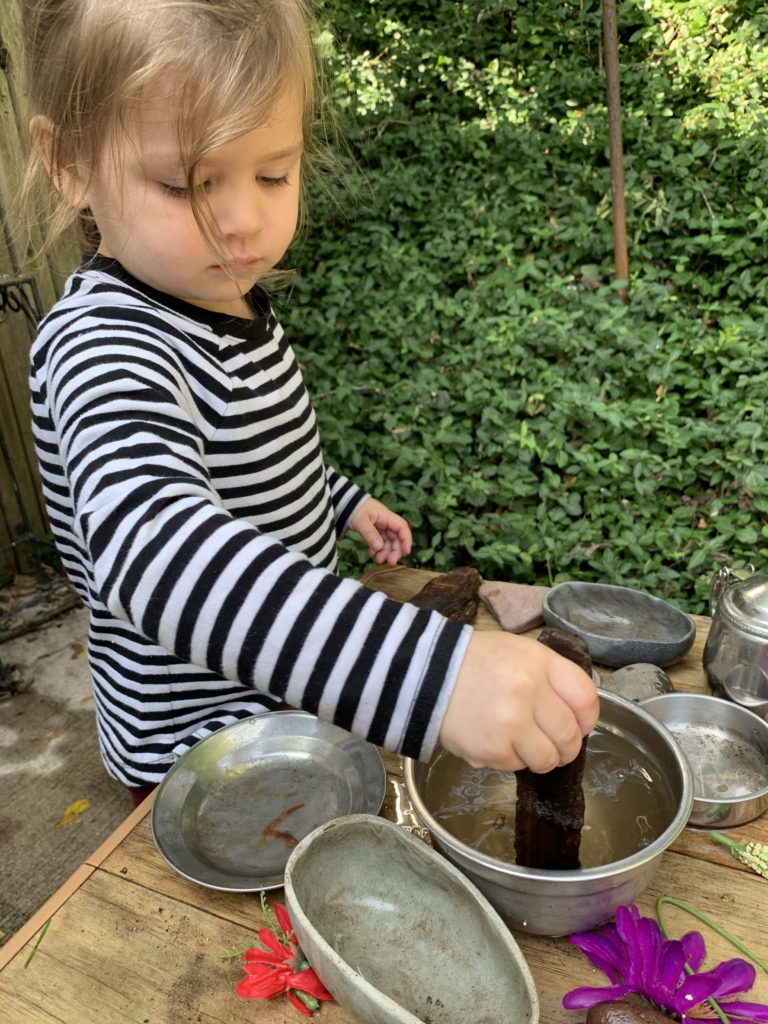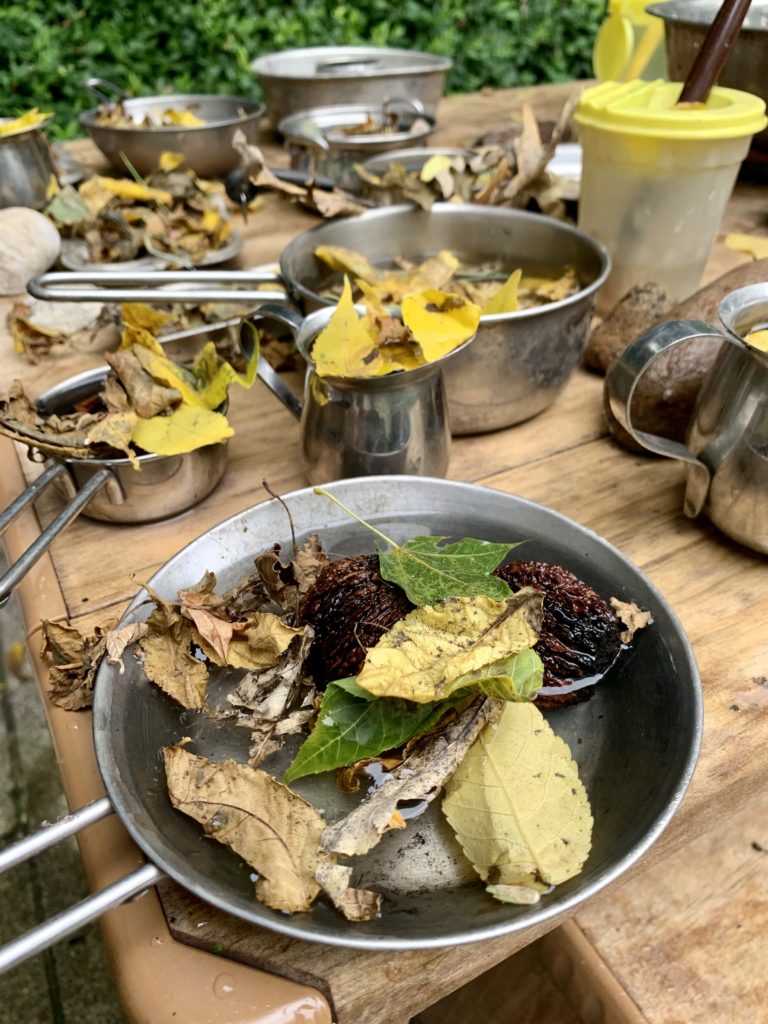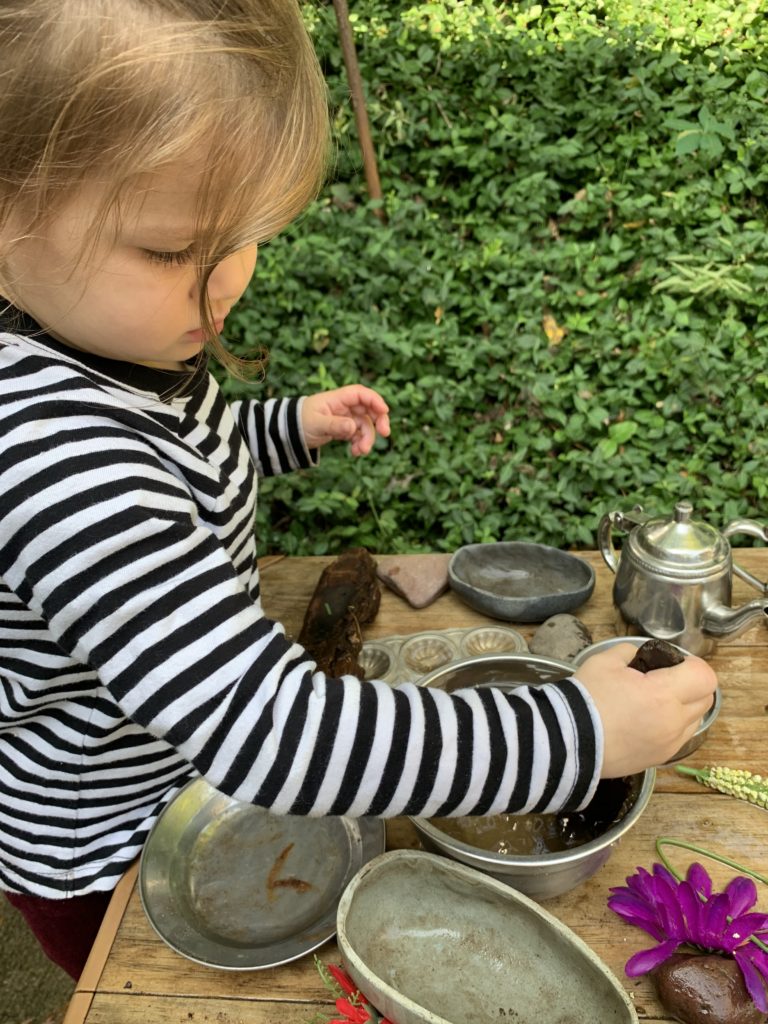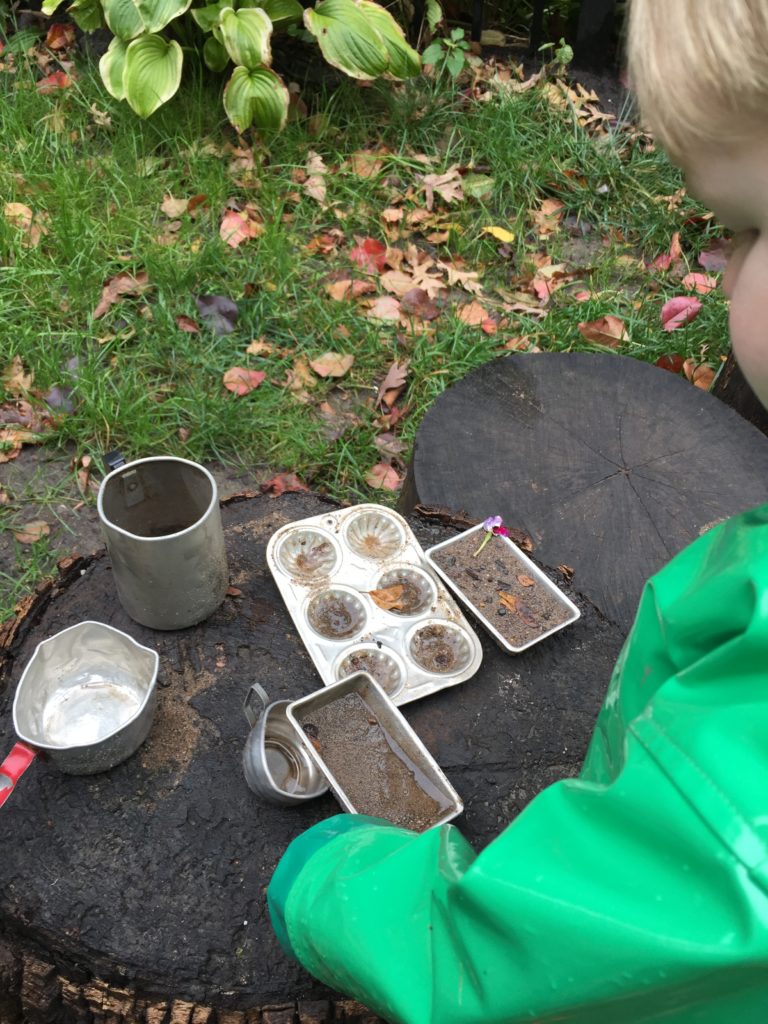A Morning in the Science Lab
“Who wants to play chemistry with me?” asks five-year-old Katie.
“What is that?” asks Annika as she jumps off of her swing to see what adventures this moment may bring.

“You mix things up, like concoctions or recipes,” Katie explains. “Sometimes things change colors or the mixture gets real thick and gooey. It’s an experiment. You don’t know what will happen until you mix stuff up and find out!”
Annika’s eyes widen with intrigue as she ponders the possibilities. “Ok, I’ll play! What do we need?“
“Water, walnuts, flowers, acorns… anything you want!” Katie responds.

The hunt is on for containers, loose parts and, of course, water!
The scientific concepts that young children learn from water play are essential for early childhood educators to be aware of and promote.
We need to be able to clearly articulate the specific concepts that children encounter during play. When children use their imagination and design experiments, they are beginning to inquire, observe, compare, invent and theorize.
Science happens when children ask questions, solve problems and draw conclusions. We have cause and effect and data analysis as children test out new ideas and theories. What looks like simple play is actually early science skills and knowledge in the making!
Katie is the quintessential “Cause and Effect“ kid. She’s always one step ahead of me, asking herself, “What if I added….”
Whether we are baking muffins in the kitchen or painting at the table, she is always experimenting with adding and mixing or exploring other possibilities that haven’t occurred to me yet. She loves to mix dry ingredients with small amounts of water and then add a wee bit more water to study the change in texture. The process is painfully slow sometimes. But it’s very, very intentional as Katie enters a learning zone all her own.
“I have collected lots and lots of cups of water!” exclaims Annika, who is Katie’s perfect partner in crime today. “Can we start mixing things now?”
Annika can spend countless hours playing with water: pouring it back and forth, watching it spill over the edge of a bucket, splashing it gently, making waves and swirling it around and around.
Free play with water can build the foundation for the understanding of scientific concepts. Young scientists discover the physics of flow and motion. Children learn about volume and measurement and experiment with solutions and cohesion, the basis of chemistry.

I watch as our youngest friend, Anderson, quietly joins the water and chemistry gang to play alongside the older children.
“Here Anderson, add some sand to that and mix it all up!” Katie instructs.
“Where did the water go?” asks Anderson, with a worried frown when the water “disappears.” “I did what you said. I added sand and it got …wet. Did I do it wrong?”
Katie takes charge of the situation, clearly relishing her role as teacher.
“You added so much sand, the water was absorbed!” she points out. “Now you have something new! What is it? Did you make peanut butter? It looks like peanut butter. Does it smell like peanut butter?”
Anderson looks confused as he takes a sniff of the mixture. The older children erupt in laughter, and Anderson smiles as he begins to understand the game. The scientific inquiry has begun—and a whole new chapter of learning has become our curriculum for the day. This is child-led learning!
Katie is always coming up with new scientific explorations, encouraging her peers to make observations, collect data and share the conclusions that they draw from their investigative play.
It’s joyous, messy and, yes, exhausting at times. But Katie brings so much more to the table than a little messiness. Learning happens when novice and experienced learners interact and collaborate. She brings her love of science to us all.

I love water play because it has no boundary lines. Regardless of the age, vocabulary or maturity of the child, water levels the playing field. Social and vocabulary skills grow as younger children play with older friends. Water play encourages collaboration, concentration, perseverance, self-regulation and more. Water also provides a sensory learning experience of immense proportions. Consider water a key science tool that enhances young children’s learning.

If you feel overwhelmed at the thought of teaching science to young children, I guarantee that you can meet nearly every early learning standard with water. It looks like play, but we can see so much learning going on when we find the time to observe. Water often creates such a play buzz that you may actually find the time to do that! Don’t feel the need to” teach.” Children learn best when they can work their ideas through on their own.

“Children learn most readily and easily in a laboratory-type environment where they can experiment, enjoy and find out things for themselves.” (Simon Nicholson, 1972 Theory of Loose Parts)
Do you ever consider your program a laboratory for early learning? When children play with natural science materials such as water, sand and loose parts, this is their science lab.
Children who participate in active investigations are engaging in the work of real scientists! Through play with loose parts, children use curiosity, persistence and motivation to answer questions, solve problems and try out their ideas to find their own answers. This is science!
Chemistry, anyone?
To expand on this activity, try this Loose-Parts Science Lab lesson!
